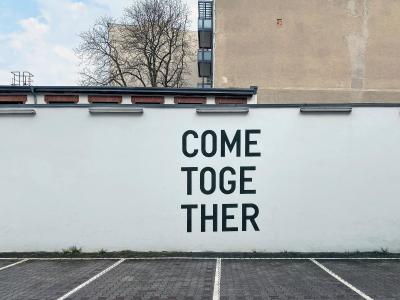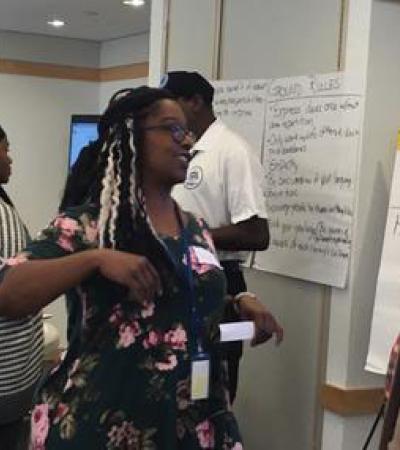Libraries of all types are taking on new roles and responsibilities. Through robust programming agendas, they’re at the center of community-building efforts all across the United States.
As part of the National Impact of Library Public Programs Assessment (NILPPA), Knology sat down with advisors from across the library sector to discuss the impacts libraries aim to have on the communities they serve. During these discussions, we also brainstormed ways to track these impacts across various domains of community life. Two important ideas emerged from our conversations:
- Image

How can libraries make communities more connected? Impact Domains
Specific areas where library programs can make meaningful differences in people’s lives. We defined nine of these. Libraries can help create: (1) connected communities; (2) knowledgeable communities; (3) creative communities; (4) civically engaged communities; (5) healthy communities; (6) economically vital communities; (7) welcoming communities; (8) joyful communities; (9) caring communities.
- Indicators
Ways of measuring the real-world impact of library programming. These Indicators allow us to determine whether or not programs are having their intended effects.
In this series of blog posts, we’d like to talk about each of these impact domains individually, and talk about how libraries are contributing to each of them. In this first post, we focus on our first impact domain: connected communities.
What are Connected Communities?
The word "connected" can mean many things to many people. For NILPPA, we’re defining connected communities as those with high levels of social capital. “Social capital” is a term used frequently in sociology, with various definitions. For NILPPA, we follow Robert Putnam's definition of social capital as "the intangible benefits people gain access to through social relationships, and in particular, to those norms and networks that facilitate trust, cooperation, reciprocity, and collective action" (paraphrased from Putnam, 1995). That is, communities with strong connections (high social capital) follow mutually agreed-upon norms and give back to others and to the community as a whole. This can contribute to other impact areas such as civic engagement, welcoming newcomers, and caring for others, which we'll go into more depth on in future blog posts.
Example: Doing Local History at the Brooklyn Public Library
Brooklyn Public Library in New York runs a program in which 4th-12th grade students explore the history of their area through archival documents. Staff from the library's Center for Brooklyn History work with students during both field trips and school visits on a semester-long research project. While the primary aim of the program is to build research skills, in evaluation surveys youth also reported that they felt more connected to Brooklyn and more aware of how past events continue to affect their community today.
Participating students also felt more strongly connected to their local community, developing their identities as Brooklynites rather than just people who happen to live there. These students were motivated to be a force for change in addressing current issues in their community such as redlining, gentrification, and the inequitable impacts of COVID-19. In this case, social capital (students' connection to their local community) opens the door to reciprocity (giving back to the community) and collective action.
To learn more about this program, check out Knology's evaluation here.
How Can You Make Your Community More Connected?
Brooklyn Connections is a time-intensive program made possible by dedicated staff, funding from nonprofit partners, and coordination with participating schools. But libraries' role as a "third space" makes them well-positioned to connect people with each other and the community they share, even with more limited resources. Libraries can help build social capital by creating spaces and programs that encourage interactions among patrons, and by connecting individuals to those outside their typical in-groups (that is, people they do not consider family, friends, or co-workers). Particular examples of this might include:
- Programs targeting diverse audiences, which bring together people who might not interact as frequently outside of the library, and that result in new connections between community members who might have formerly regarded each other as strangers.
- Cooperative projects that help participants see themselves as part of a larger whole, like bringing people together to create a community garden or StoryWalk.
- Programs focused on discussion of issues facing the community (such as the discussions held through the ALA's Libraries Transforming Communities initiative), which can strengthen norms around constructive communication and collaboration.
Let’s Put it To Work!
We’re interested in learning more about how you think libraries can create more connected communities. How do programs at your library help build social capital within the community? What partnerships do you have that help you meet this goal? And how else might libraries forge stronger community connections?
Let us know what you think about these things. You can either comment below or email programminglibrarian@ala.org. And for more information on this topic, please consult the literature cited below.
References & Additional Resources
Goulding, A. (2004). Libraries and social capital. Journal of Librarianship and information science, 36(1), 3-6.
Hillenbrand, C. (2005). Public libraries as developers of social capital. Australasian public libraries and information services, 18(1), 4-12.
Hoyer, J., Holt, K., Voiklis, J., Attaway, B., & Joy Norlander, R. (2022). Redesigning Program Assessment for Teaching with Primary Sources: Understanding the Impacts of Our Work. The American Archivist, 85(2), 443–479. https://doi.org/10.17723/2327-9702-85.2.443
Johnson, C. A. (2012). How do public libraries create social capital? An analysis of interactions between library staff and patrons. Library & information science research, 34(1), 52-62.
Putnam, R. D. (1995). Bowling alone: America’s declining social capital. Journal of Democracy, 6, 65-78.
Vårheim, A. (2007). Social capital and public libraries: The need for research. Library & Information Science Research, 29(3), 416-428.
These materials were produced for National Impact of Library Public Programs Assessment (NILPPA), a project funded by the Institute of Museum and Library Services. The authors are solely responsible for the content on this page.
Written by Knology. This blog has been co-posted on Programming Librarian, NILPPA and the Knology website.
Knology is a nonprofit research organization that produces practical social science for a better world. The organization pursues this goal to help professionals in a variety of sectors build inclusive, informed, and cooperative societies that can thrive together with the natural systems on which we all depend. As a transdisciplinary collective of over 30 social scientists, writers and educators, the organization's work process is built on equity, transparency and deliberation.



